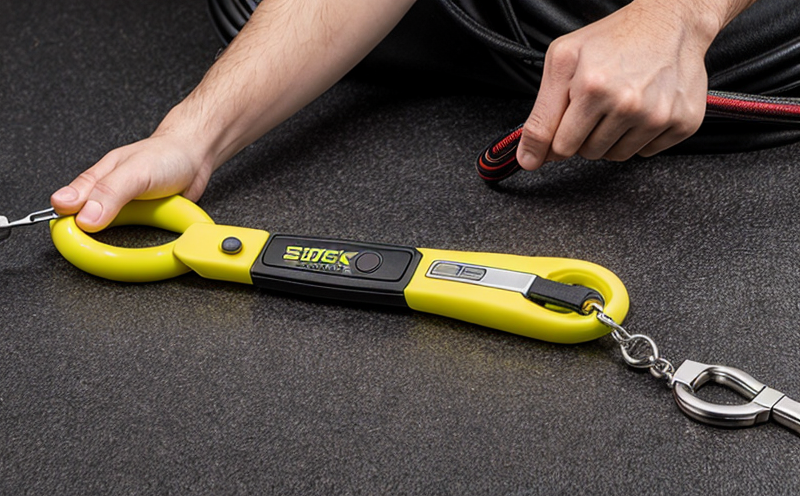Shock absorbing lanyard inspection
The inspection of shock absorbing lanyards is a critical step in ensuring worker safety and compliance with international standards. Shock absorbing lanyards are an essential component of personal protective equipment (PPE) designed to reduce the impact forces experienced by workers during falls from heights. These lanyards are typically made from high-strength materials like aramid fibers, which provide both strength and flexibility necessary for effective performance.
The inspection process involves several key steps aimed at verifying that the lanyard meets rigorous safety standards. The first step is visual inspection, where any visible damage or wear on the lanyard is noted and documented. Following this, a tensile test is conducted to determine the breaking strength of the lanyard under controlled conditions. This helps ensure that the lanyard can withstand the forces exerted during a fall without failure.
Impact tests simulate real-world scenarios where the lanyard might be subjected to significant force. These tests are designed to mimic sudden impacts, providing insight into how well the lanyard absorbs shock and protects against injury. Additionally, dynamic testing is performed to evaluate the lanyard's performance under rapid loading conditions, which closely resembles actual fall situations.
Environmental considerations also play a crucial role in the inspection process. Lanyards must be tested for resistance to various environmental factors such as temperature extremes, moisture, and chemicals that they might encounter during use. This ensures that the lanyard remains functional under diverse working conditions.
The importance of regular inspections cannot be overstated. Compliance with international standards like ISO 14928-1:2015 and ANSI Z359.6-2017 is mandatory to ensure safety and regulatory compliance. These standards provide detailed guidelines on the design, construction, and testing procedures for shock absorbing lanyards.
Regular inspections not only enhance worker safety but also contribute significantly to maintaining a positive company image. By adhering to strict inspection protocols, companies demonstrate their commitment to employee well-being and adhere to industry best practices. This can lead to improved workplace morale, reduced accidents, and increased productivity.
Why It Matters
The importance of shock absorbing lanyard inspections cannot be overstated in the realm of occupational safety and health (OSH). These inspections serve as a critical line of defense against potential injuries resulting from falls. By ensuring that lanyards meet stringent safety standards, companies can significantly reduce the risk of workplace accidents.
Shock absorbing lanyards are designed to absorb and distribute the impact forces experienced during a fall, thereby minimizing the likelihood of serious injury. Regular inspections help identify any signs of wear or damage that could compromise their effectiveness. This proactive approach ensures that workers are equipped with reliable PPE, enhancing overall safety in the workplace.
Compliance with international standards is not only a legal requirement but also an essential aspect of maintaining a safe and healthy work environment. Failure to conduct proper inspections can lead to non-compliance issues, which may result in fines or other penalties. By adhering to these standards, companies demonstrate their commitment to safety and regulatory compliance.
The role of quality managers, compliance officers, R&D engineers, and procurement specialists becomes crucial in this context. Quality managers ensure that the inspection process is conducted consistently and effectively. Compliance officers oversee adherence to legal requirements, while R&D engineers contribute by developing innovative solutions to improve lanyard performance. Procurement specialists play a vital role in sourcing high-quality materials and ensuring consistent supply chains.
In conclusion, shock absorbing lanyard inspections are indispensable for maintaining worker safety and compliance with international standards. By prioritizing these inspections, companies can create safer workplaces and contribute to the overall well-being of their employees.
Applied Standards
| Standard | Description |
|---|---|
| ISO 14928-1:2015 | This standard provides guidelines for the design, construction, and testing of shock absorbing lanyards. It ensures that these devices meet strict safety requirements. |
| ANSI Z359.6-2017 | An American National Standard for personal fall arrest systems, including shock absorbing lanyards. This standard specifies performance criteria and testing methods to ensure the reliability of such equipment. |
The application of these standards guarantees that shock absorbing lanyards are manufactured and tested to the highest safety standards. Compliance with these international guidelines ensures worker protection during falls from heights, thereby enhancing occupational safety and health.
Competitive Advantage and Market Impact
- Ensures compliance with international safety standards
- Promotes a culture of safety within the organization
- Enhances worker confidence in their protective equipment
- Reduces the risk of workplace accidents and injuries
- Improves overall productivity by minimizing time lost due to accidents
- Gains competitive advantage through reputation for excellence in occupational safety
- Aids in maintaining regulatory compliance, avoiding potential fines or penalties
- Promotes employee morale and satisfaction, contributing to a positive work environment
By adhering to rigorous inspection protocols and ensuring that shock absorbing lanyards meet the highest safety standards, companies can gain significant competitive advantages. This commitment to worker safety not only enhances reputation but also contributes positively to the overall market impact by setting industry benchmarks for occupational safety.





